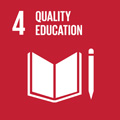- Docente: Luca Evangelisti
- Credits: 3
- SSD: CHIM/02
- Language: English
- Teaching Mode: In-person learning (entirely or partially)
- Campus: Ravenna
- Corso: Second cycle degree programme (LM) in Science for the Conservation-Restoration of Cultural Heritage (cod. 8537)
-
from Oct 21, 2024 to Nov 18, 2024
Learning outcomes
At the end of the course the student knows the theoretical foundations and the operating principles of the instrumentation used in spectroscopy applied to cultural heritage. The student is also able to predict and interpret the spectra obtained from the analysis of materials present in artistic and historical samples.
Course contents
Electromagnetic Radiation and the Electromagnetic Spectrum. Introduction to Instrumental Analysis. Elements of Optics. Energy States of a Free Molecule and Population of Levels. Ultraviolet-Visible (UV-Vis) Spectroscopy: Generalities. The Color of Objects. Examples of UV-Vis Spectra. Instrumentation. Lambert-Beer's Law. Types of Electronic Transitions. Derivative Spectrometry. Fluorescence and Phosphorescence. Jablonski Diagram. Generalities on Infrared (IR) Spectroscopy. Vibration of Diatomic Molecules: The Harmonic Oscillator Model. Vibrations of Polyatomic Molecules: Normal Modes, Vibrational Transitions, and Related Absorption Bands. Interpretation of Infrared Spectra. Characteristic IR Absorption Bands of Some Classes of Organic Compounds. Infrared Spectra of Some Materials Used in Art and Historical-Artistic Heritage Conservation. Exercises on Infrared Spectrum Interpretation. Reflectance Infrared Spectroscopy. Raman Spectroscopy: Generalities and Basic Concepts. Comparison between Raman and Infrared Spectroscopy. Examples of Raman Spectra. Applications of Raman Spectroscopy to Cultural Heritage. Flame Photometry. X-Ray Fluorescence Spectroscopy. Plasma Spectroscopy.
Readings/Bibliography
P.W. ATKINS, Physical Chemistry
During the lectures, guidance on reference texts will be provided, all of which are available in the libraries. Additionally, supporting articles and reviews will be provided.
Teaching methods
The course consists of lectures where concepts are introduced with the support of a traditional blackboard or video projection.
Assessment methods
The final exam is oral and aims to assess, based on a topic chosen by the student and two or more questions on the main topics covered, both the acquisition of the knowledge specified in the course syllabus and the student's ability to navigate the topics discussed, including the use of bibliographic material provided by the instructor.
Teaching tools
The power point presentations used during the lessons and in-depth material will be provided. This material is made available to the student in electronic format via the internet. The power point presentations used during the lessons will be uploaded in advance of the corresponding lessons. It is suggested to print the presentations and bring them to class.
Students who need compensatory tools for reasons related to disabilities or specific learning disorders (SLD) can directly contact the Service for Students with Disabilities (disabilita@unibo.it) and the Service for Students with learning disabilities (dsa@unibo.it) to agree on the adoption of the most appropriate measures.
Office hours
See the website of Luca Evangelisti
SDGs

This teaching activity contributes to the achievement of the Sustainable Development Goals of the UN 2030 Agenda.
